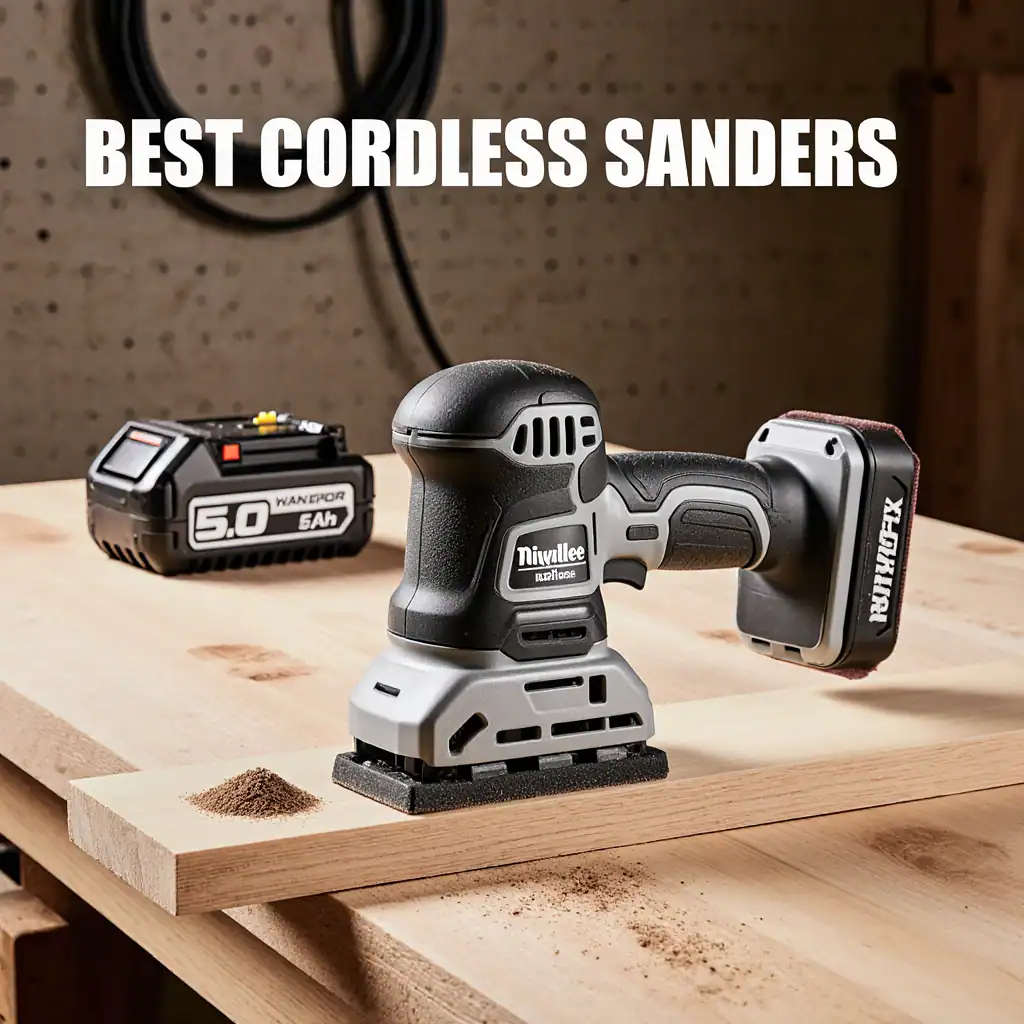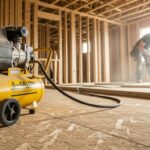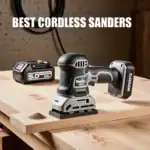You know the moment. You’re sanding a project on sawhorses, maybe trying to refinish an old piece of furniture. You’re constantly fighting the extension cord—it snags on the corner, it unplugs, and it’s always in the way. You look over and see those sleek, cordless models and wonder: “Is it time to cut the cord?”.
The Old Truth: Let’s be honest. For years, cordless sanders were junk. They were weak, vibrated your hand into a numb claw, and the battery died in 10 minutes flat. They were essentially expensive toys, especially since they just weren’t as powerful as our trusty corded sanders.
The New Truth: Thanks to modern innovations like brushless motors and massive battery improvements, they are finally good. Really good. Over the last few years, there have been dramatic improvements to both their performance and battery life, making them genuinely useful tools.
I’m not just going to list specs here. I’ve used these. I’m going to tell you who each one is for, why it’s good, and what will drive you nuts about it.
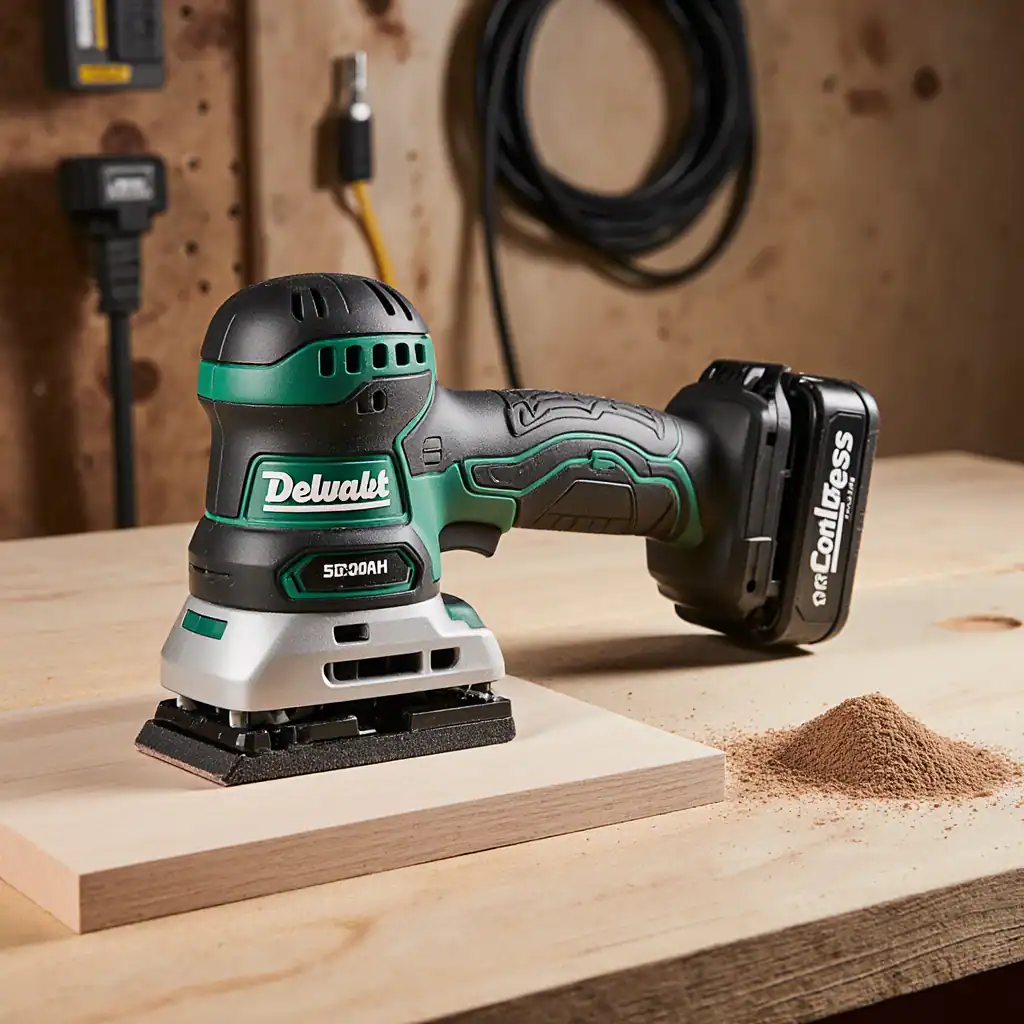
My “No-BS” Test: What Actually Matters
Before we dive into the list, you need to know how I judged these tools. When switching from a corded tool to battery power, a few factors are make-or-break:
- Power vs. Vibration: Does the sander actually remove material quickly, or does it just buzz and make your hand numb? A good cordless sander needs power you can feel but shouldn’t feel like holding a paint shaker.
- Battery Life (The Big One): This is the make-or-break spec. Can it last long enough to finish a job, or will you be swapping batteries every 10 minutes? All my testing was done with a 4.0Ah or 5.0Ah battery, minimum.
- Ergonomics (How it Feels): Whether you’re sanding for 10 minutes or an hour, comfort matters. Is it a balanced palm sander, or a top-heavy monster you have to fight? Lighter sanders create less hand and wrist fatigue, especially on vertical surfaces.
- Dust Collection: Sanding creates a lot of sawdust, which is hazardous to your health and annoying to clean. I checked if the built-in canister was a total joke and, more importantly, if you can actually hook up a shop vac.
The 5 Cordless Sanders I Actually Recommend
Cordless sanders fall into different categories, and the “best” choice depends entirely on the job: stock removal, finishing, or detail work.
| Category | Recommended Model | Max Speed (OPM) | Key Feature |
|---|---|---|---|
| All-Around Workhorse (Best ROS) | Makita XOB01Z 18V LXT | 11,000 OPM | Variable Speed + Stunning Quality |
| Budget Powerhouse (Best Value) | Ryobi P411 One+ 18V ROS | 10,000 OPM | Very Inexpensive Price, Solid Performance |
| Detail King (Best Mouse Sander) | BLACK+DECKER BDCMS20C 20V MAX | 12,000 OPM | Fantastic Quality + Detail Finger Included |
| The Cord-Cutter (Pro-Level Power) | Milwaukee 2648-20 M18 ROS | 12,000 OPM | Pro-Level Brushless Motor |
| The Finisher’s Friend (Sheet Sander) | Ryobi One+ 18V Quarter Sheet Sander P440 | 12,000 OPM | Potent and Lightweight for smooth finishes |
The Reviews
1. The All-Around Workhorse: Makita XOB01Z 18V LXT Cordless Random Orbit Sander
- Three speed settings (7,000/9,500/11,000 OPM) engineered for faster material removal
- Large 1/8" random orbit action engineered for fast sanding and swirl-free finish
- One-touch electronic speed control switch provides fast, medium and low settings
- One-touch electronic speed control switch provides fast, medium and low settings
- Makita XOB01Z 18V LXT Lithium-Ion Cordless 5" Random Orbit Sander, Tool Only
Best For: The homeowner or serious woodworker who needs a primary, reliable sander that offers power, comfort, and durability.
The Good (My Experience):
This is, in my opinion, the best all-around cordless sander I’ve used. It’s a fantastic machine that delivers incredible quality and value for the price. The 18V battery offers both power and endurance, coupled with the great feature of variable speed. You can choose from three speed settings: 7,000, 9,500, or a maximum of 11,000 Orbits Per Minute (OPM), which is excellent for adapting the speed for rough stock removal all the way up to a fine polish.
That 1/8-inch orbit is the sweet spot for a great, scratch-free finish. In my testing, this was the smoothest cordless model of the bunch. The body is very well-built, smartly designed, and the sturdy construction should last for years of hard work.
The Bad (The Honest Truth):
The battery life varies significantly: it lasts 40 minutes at low speed, but only about 20 minutes at high speed. The buttons used for speed adjustments are strangely marked (0 for off, 1, 2, 3 for speed change), which can make turning it off confusing at first. Also, note that the batteries and charger are typically sold separately.
Who It’s For: The homeowner or serious woodworker who wants one cordless sander to do it all, and do it well. It’s the top choice for overall cordless sanders.
Who It’s NOT For: Someone strictly on a budget, as the purchase price plus battery/charger can be high.
2. The Budget Powerhouse: Ryobi P411 One+ 18 Volt Cordless Random Orbit Sander
- 10,000 orbits per minute for a smooth, swirl-free finish
- Dust Collection Port accepts 1-1/4 in. & 1-7/8 in. vacuum hoses
- 40% reduced vibration for maximum control
- Hook & Loop sanding pad for easy sandpaper attachment
Best For: The DIY’er or hobbyist who needs a competent, everyday tool for lighter work at a very inexpensive price.
The Good (My Experience):
The Ryobi P411 is a solid, competent cordless sander that delivers a high-quality finish with its 10,000 OPM speed on a 5-inch pad. It has a helpful lock-on button so you don’t tire your hands, and an efficient dust collection system (bag included). It is comfortably held thanks to its ergonomic shape and rubberized grip. It is lightweight, very well-balanced, and provided 35 minutes of battery life in testing. For the price, it’s a solid cordless random orbital sander.
The Bad (The Honest Truth):
It lacks more advanced features, most notably variable speed. Without variable speed, you have less control when working with delicate woods or fine polishing. In one test, the dust collection bag would sometimes fly off unexpectedly, resulting in a large cloud of fine particulate dust. As with many tools, the battery and charger are sold separately.
Who It’s For: Someone who needs a great balance of price, power, and battery life for the money. It’s a no-brainer if you just need to get the job done.
Who It’s NOT For: The professional who needs variable speed control or who frequently requires dust extraction via a vacuum hose.
3. The Detail King: BLACK+DECKER BDCMS20C 20V MAX MOUSE Sander
- FAST MATERIAL REMOVAL – At 12,000 opm (oscillations per minute), this sander quickly clears away material.
- DETAIL FINGER ATTACHMENT – Helps sand hard-to-reach surfaces.
- 2-POSITION GRIP – Allows for enhanced control during a variety of applications.
- HOOK-AND-LOOP SYSTEM – For convenient sandpaper changing.
- COMPACT, ERGONOMIC DESIGN – Simple to maneuver in corners and tight spaces.
Best For: Getting into tight spaces, corners on window trim, sanding furniture legs, or intricate details of any piece.
The Good (My Experience):
In my honest opinion, the BDCMS20C is the best cordless detail sander you can get for the price. It is potent and enduring, offering incredible quality in its design and construction. Don’t get fooled by the 20V MAX label; that’s just marketing. It’s the same 18V power as the others, but that’s not a bad thing. It has plenty of juice for detail work and outputs a superb 12,000 OPM, ensuring a clean, high-quality finish.
The design is smart, featuring two different rubberized grips for comfort and easy maneuvering, and the switches are dust-sealed for durability. It includes a detail finger attachment, which is indispensable for sanding super tight spaces. The dust collection is truly top-notch.
The Bad (The Honest Truth):
The warranty is only 2 years. The size and weight are overkill for simple, large, flat surfaces; this tool is weak, but that is the point—it’s for tight spots, not big surfaces.
Who It’s For: Anyone working on cabinets, trim, or detailed furniture pieces who needs a compact sander to excel at intricate details.
Who It’s NOT For: Projects that require heavy material removal, as detail sanders are designed for precision finishes.
4. The “Cord-Cutter” (Pro-Level Power): Milwaukee 2648-20 M18 Random Orbit Sander
- Milwaukee Electric Tools 2648-20 M18 Random Orbit Sander
- This product meets customer requirement
- Product is easy to use
Best For: Professionals or serious DIYers who are already in the Milwaukee battery system and need a high-quality, powerful tool built for heavy-duty use.
The Good (My Experience):
This is the one that really feels like a corded tool. It is built to last with a high-quality construction and backed by a long 5-year warranty. It features a powerful brushless motor with variable speed control, adjustable from 7,000 to 12,000 OPM, that just feels like it has more torque than the others. The operation is smooth, and the comfortable, tacky rubber grips make it easy to control. A useful feature is that the sander stops almost immediately after powering off, allowing you to set it down quickly.
The Bad (The Honest Truth):
It’s a bit heavier than most orbital sanders (4.3 lbs with a 5Ah battery). The battery life (around 35 minutes) is slightly less than some competitors. The design of the hard plastic dust collection box is cumbersome and makes it difficult to use in tight spaces, offering less maneuverability than soft bag models.
Who It’s For: If you’re a professional, this is your huckleberry. It is practical for smoothing out large, wide open surfaces like table tops or wood siding.
Who It’s NOT For: Users who need superior mobility in tight spaces, due to the bulkiness of the dust box and battery.
5. The Finisher’s Friend: Ryobi One+ 18V Quarter Sheet Sander P440
Best For: Finishing work before applying paint or stain, or when you need a perfectly smooth surface on flat materials without the slight “pigtail” swirl marks that random orbital sanders can sometimes leave.
The Good (My Experience):
Sheet sanders are favorites among many because they are one of the easiest sanders to use and deliver highly-polished finishes. This model is compact, very inexpensive, potent, and lightweight. It delivers a great 12,000 OPM which is enough power for a variety of tasks. It is lightweight and handles well, making it easy to maneuver across flat surfaces. The 18V battery lasts around 35 minutes.
The Bad (The Honest Truth):
It’s a quarter sheet sander, meaning it is specifically meant for finishing work and is not designed for tough, heavy stock removal. It is a great entry-level sander, but lacks the advanced features found in premium models like the Festool RTSC 400 (which also offers variable speed and hybrid functionality).
Who It’s For: Entry-level users, or professionals/DIYers who already own a random orbital sander and need a lightweight tool dedicated solely to achieving the smoothest possible finish.
Who It’s NOT For: Anyone whose primary task is aggressively removing old paint or varnish.
My Most Important Tip: It’s All About the Battery
I’m serious. Stop! Do not buy a cordless sander with a 1.5Ah or 2.0Ah battery. You will get 10–12 minutes of runtime, and you will hate it.
Sanding is a “high-draw” task that sucks battery life like crazy because the motor is running constantly under resistance. While the runtime depends heavily on how you use the tool, general advice holds true.
My Rule: You need a 4.0Ah battery, minimum. A 5.0Ah or 6.0Ah battery is even better for maximum endurance. I’ve found I get about 30 to 45 minutes on a single charge with a quality battery, and I always keep a spare battery on hand to continue working while the first charges.
The “Friend” Advice: Honestly, the best cordless sander for you is probably the one that matches the big batteries you already own. If you have a bunch of Ryobi batteries, get the Ryobi. If you’re on Team Red (Milwaukee), get the Milwaukee. Don’t start a whole new battery system just for a sander.
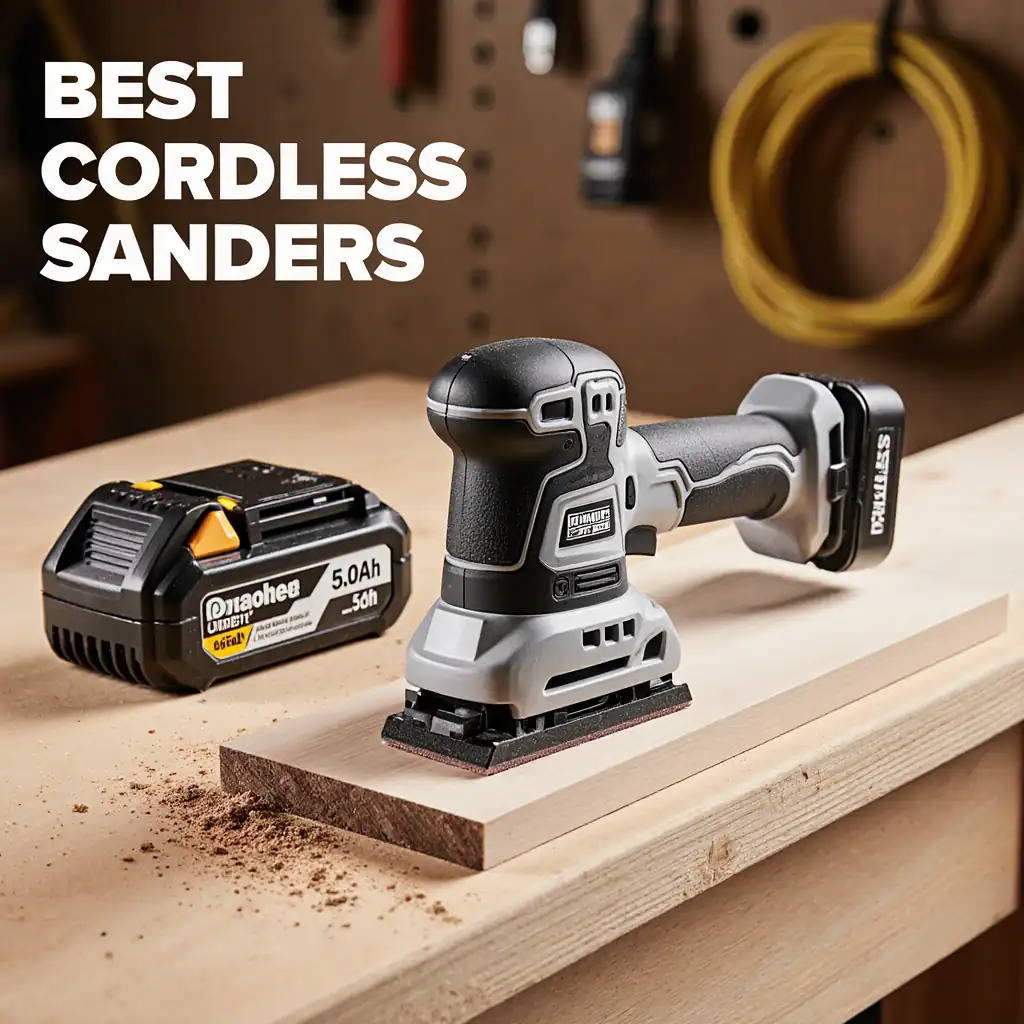
The Final Verdict: So, Which One Should You Buy?
Choosing the right cordless sander depends on your most frequent application.
- If you’re a beginner or on a budget: Get the Ryobi 5″ Random Orbital Sander. It’s the best balance of price, power, and battery life for the money.
- If you’re a serious DIYer or woodworker: Get the Makita XOB01Z 5″ Random Orbital Sander. It’s powerful, versatile, offers variable speed, and is truly the most essential cordless sander to have in your shop.
- If you just do small crafts or refinish furniture with tight corners: Get a Detail Sander, such as the Black+Decker Mouse. Its unique triangular pad is made for those annoying, intricate details.
My old corded sander still comes out for the huge jobs, like stripping an entire deck. But for nearly every other project? I grab my cordless model every single time. The freedom to work anywhere is just too good to go back.

